Why does thuja turn yellow and what to do: causes and methods of recovery
A very sad sight in spring or autumn is the yellowed, brownish twigs of evergreen thuja, sometimes covered with a grayish bloom. One should react extremely quickly and responsibly to such a clearly painful state of a beautiful coniferous tree.
Our article will tell you how to figure out the causes of the general darling's ailment during the warm period, how to help her (what to do if the thuja has turned yellow).
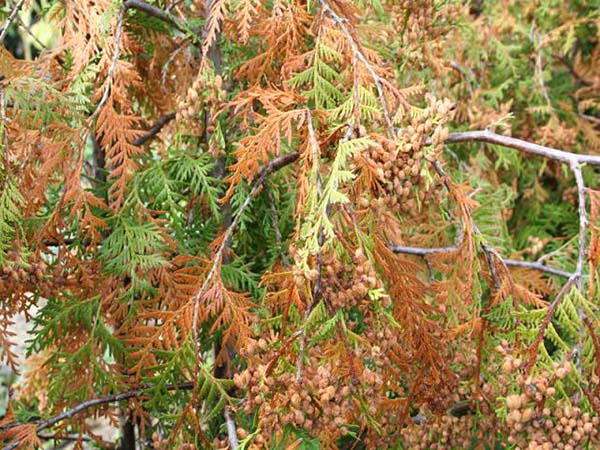
Content
Why thuja began to lose its decorative effect and began to turn yellow
Thuja loses its decorativeness - its yellowing, as a rule, occurs due to a whole complex of reasons. This may be neglect and the lack of the necessary care for the plant itself, which is why the ephedra has a deficiency of nutrients in the soil and problems with the root system of the plant begin. It is possible that the plant got sick or was attacked by pests, and an initially incorrect one may have a negative effect. planting thuja in open ground.
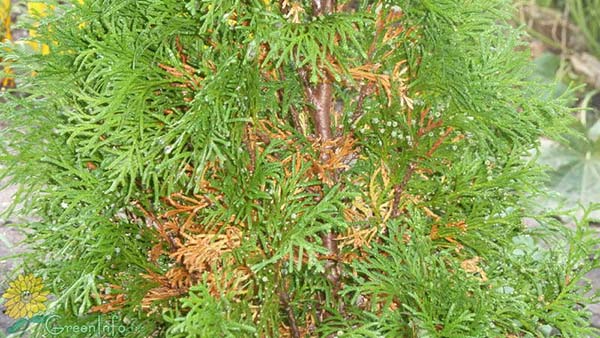
Note! Thuja needles can turn yellow in the fall for a natural reason - due to the loss of it chlorophyll, a substance that provides nutrition to the needles. Thus, they turn yellow, dry out and die, and then new green needles appear in the same place. This is a normal natural life cycle that occurs with thuja every 3-6 years.
Also, at the end of autumn, thuja needles may turn yellow due to natural defensive reaction of ephedra to a cold snap, then she will turn green herself again.
Next, we will dwell in more detail on each reason why the thuja began to turn yellow and what needs to be done to save the tree and restore its decorative effect.
Important! Whatever the reason, the yellowing and drying of the thuja needles, all affected branches must be cut out mercilessly. In this case, it is enough to simply remove only the dried "leaves", since the greenery will still grow on the branches. Do not leave yellow needles if you want to save the tree!
Video: why thuja turns yellow and how to save it
Insufficient or improper care of thuja
Thuja most often dries up and turns yellow due to lack of moisture in the crown and root system of the ephedra. Therefore, on sunny hot summer days, the needles should be irrigated regularly by sprinkling (sprinkling), and a sufficient amount of water should be poured into the trunk circle itself, which should be mulched so that moisture can linger longer.
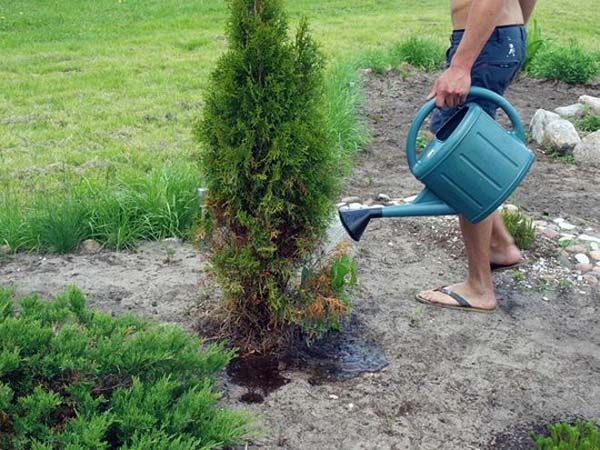
True, everything can be the other way around: thuya receives too much moisturewhich stagnates due to poor drainage. In this case, you need to either transplant it, or somehow adjust the drainage system, otherwise, due to stagnant moisture, the plant can get sick with one of the fungal diseases.
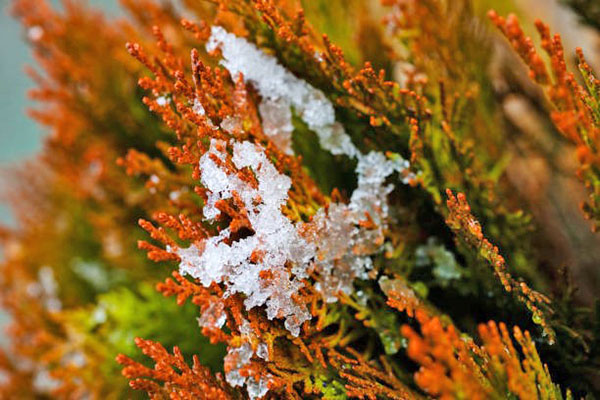
Sunburn needles appear as a result of a lack of moisture in the transitional winter-spring period. A very bright spring sun can simply burn a defenseless thuja almost to the very trunk. Therefore, in late winter - early spring (February-March), the ephedra should be shaded using, for example, a simple white material (sheet), a camouflage net or lutrasil (throw it directly onto the plant and do not remove it until April).
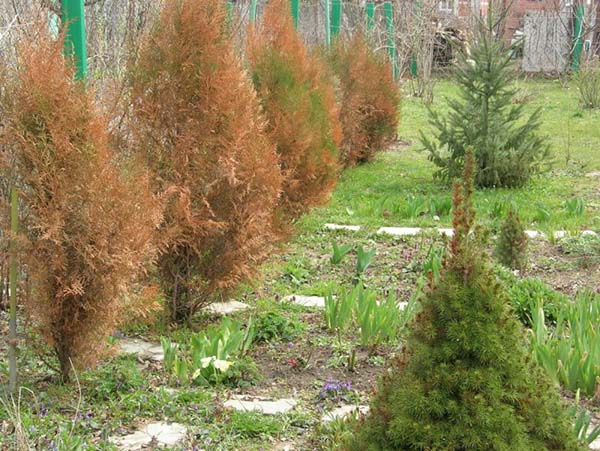
Advice! If the thuja is still damaged by the sun, then spray it with a growth stimulant, for example, epin or zircon... However, such processing is generally quite useful to do every spring.
Also, yellowing and drying of thuja needles is possible due to the fact that the roots of the plant do not have enough room to grow. As a rule, this happens 5-7 years after the seedling is planted in open ground, when it grows sufficiently and outgrows the previously made planting hole. The only way to save the tree is to transplant it to a new location.
If you planted thuja too close, then they may begin to turn yellow due to the fact that they will take away deficient nutrition from each other, and due to poor air circulation - vomit.
Another reason for yellowing (or rather drilling, the needles begin to acquire a rusty hue) of thuja is deficiency of nutrients in the soil. Therefore, do not skimp on liquid fertilizing with special fertilizers for conifers, if you do not want them to lose their decorative qualities. For example, if there is a lack of iron in the soil, it turns yellow or turns white, and the lack of phosphorus can result in a reddish-purple hue.
It is very important to conduct correct formation of thuja: if you prune too hard with a blunt tool, this can also cause yellowing (even browning) of the needles.
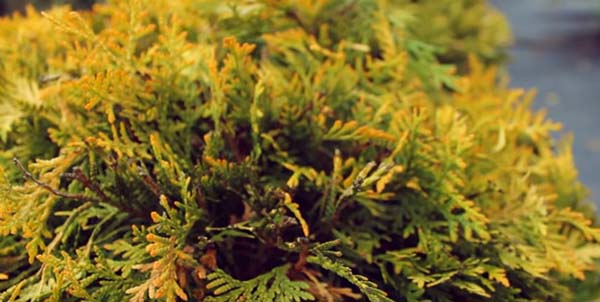
Note! An unexpected cause of yellowing and even blackening of the lower part of the crown can be urine from pets, specifically tags from dogs and cats.

Video: the main reasons for yellowing tui
Thuja diseases
In case of occurrence fungal diseases in the thuja, which caused its yellowing, it is urgent to do its sanitary pruning, and then for a long time to spray the crown of the tree with various kinds of fungicides, for example, an acrobat.
By the way! It often happens that the cause of a fungal disease in thuja is lawn. Most likely, in this case, the ephedra caught fusarium, which often happens both in the grass, and, incidentally, on the ephedra itself.
Newly planted thuja after winter, when the snow melts, may be amazed brown shute... The needles acquire a brownish tint, and then a gray-black bloom appears on it. As a preventive measure, in early spring, the ephedra should be treated Fitosporin.
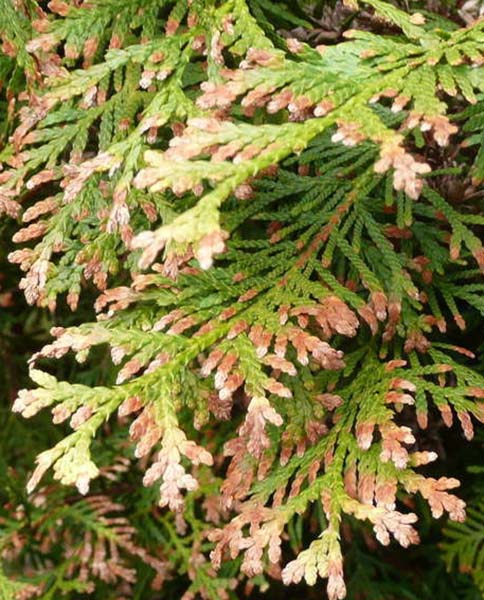
Thuja pests
It often happens that people settle on thuja pincers, the presence of which on the needles of a tree can only be determined with a magnifying glass. So, if you see small red insects, it means that ticks have started on your tree. The solution to the problem will be spraying the ephedra with Fufanon or Aktellik.
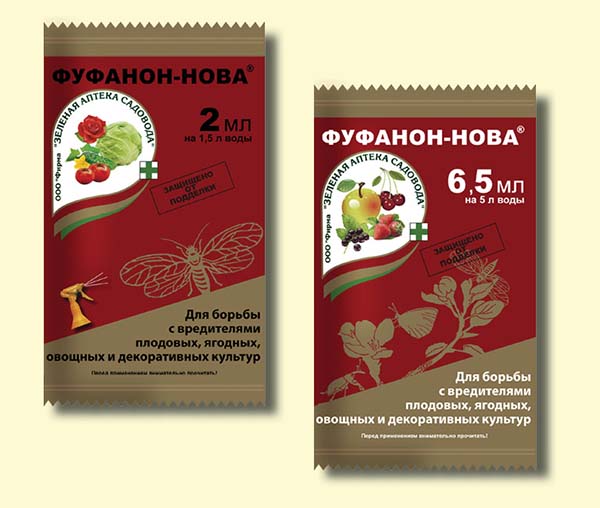
Sucking insect pests such asthuja aphid, thuja false shield, juniper scale insect, mealybug, speckled moth and bug... Because of this, in the spring, the needles of a plant can also acquire a reddish-brown color and even become covered with a grayish bloom.
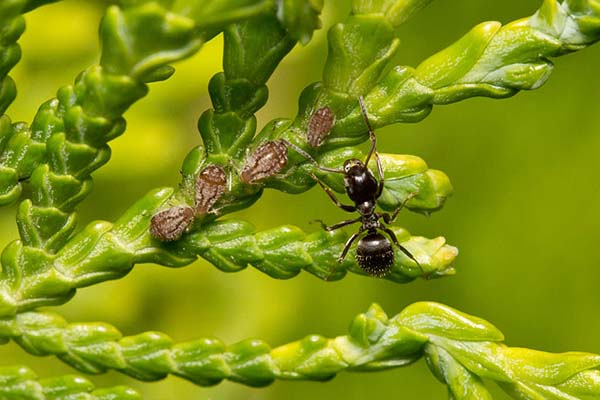
For the complete destruction of these pests in early spring, process the thuja Karbofos, and then in the summer, spray the ephedra as a preventive measure Rogor or again Aktellik.
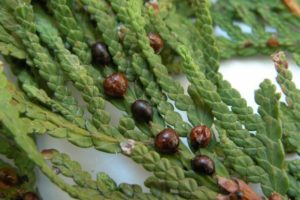
The following pests are no less harmful and dangerous for thuja:
- leafworm larvaethat make their cocoons on needles, which further causes yellowing of the shoots;
- mayfly bagworm caterpillarsthat eat coniferous branches;

- weevil beetles, which are able to gnaw and damage the bark and needles of a plant;
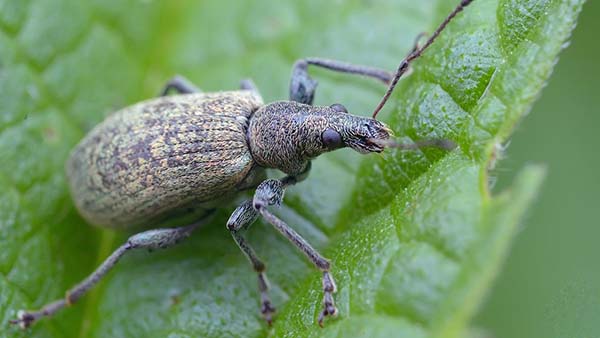
- thuy bark beetle (similar to the spruce bark beetle), which eats the bark of a tree, making holes and passages in the trunks.

To destroy these pests, in late spring and early summer, conifers should be sprayed again with "Fufanon" or "Aktellik", although such a preparation as "Confidor" is also suitable.
Note! Treatments for diseases and pests of thuja should be repeated 2-3 times a month with an interval of 1 week, and it is better to spray it in the morning or in the evening. In addition, it is imperative to observe all safety measures, performing all manipulations in a protective suit and a mask with a charcoal filter.
Thus, there are several serious reasons behind the yellowing of thuja needles, including the natural age-related reaction of the ephedra in the fall, and in the spring and summer, improper tree care and seasonal attacks of diseases and pests. We hope that our smart tips and tricks will help you prevail over all enemies of the thuja.
Video: causes of yellowing of tui

